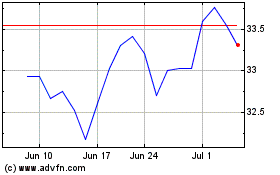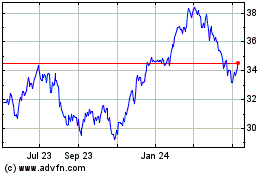CSX Board to Require CEOs to Get Annual Physical Exam -- Update
January 23 2018 - 7:46PM
Dow Jones News
By Paul Ziobro
CSX Corp. will require the railroad's chief executive to submit
to an annual physical exam that will be reviewed by the board,
adopting an unusually aggressive approach to a delicate issue just
weeks after the death of its previous CEO.
The railroad's board was under fire last year after it agreed to
hire Hunter Harrison even though he declined to get a physical exam
or provide access to his medical records -- despite concerns about
the then 72-year-old railroad veteran's health.
The board ultimately asked shareholders to vote on a pay package
that in effect would bless the arrival of Mr. Harrison. The
resolution passed with overwhelming support.
Mr. Harrison, who signed a four-year contract with the
Jacksonville, Fla., company in March 2017, died Dec. 16 following
unspecified health issues.
CSX's latest move is an attempt to address the sensitive issue
of CEO health and how much boards are entitled to know about it,
especially in cases where a company's fortunes are so closely tied
to their leaders. CSX shares surged in January 2017 on news that
Mr. Harrison wanted to run the company.
Securities laws don't explicitly require companies to disclose
executive health problems, though companies must share material
information that might affect investors' decisions to buy or sell
stock.
Apple Inc.'s board never disclosed the specific reasons for two
extended medical leaves by co-founder Steve Jobs, decisions that
angered some shareholders. Mr. Jobs died in 2011 after battling
pancreatic cancer.
United Continental Holdings Inc. told investors in October 2015
that its new CEO Oscar Munoz had been hospitalized but didn't
initially disclose that he had suffered a heart attack. He took a
medical leave, had a transplant and returned the following
year.
In 2015, Goldman Sachs Group CEO Lloyd Blankfein disclosed a
lymphoma diagnosis shortly after receiving the news from his
doctor. He said he planned to continue working through treatment
and returned to work full-time the following year.
While some companies do require CEOs to undergo annual
physicals, it isn't clear how many have to share results with the
board. The research firm Equilar Inc. couldn't find evidence that
any of the largest 500 U.S. companies considered a similar proposal
over the past five years.
Requiring executives to share their physicals with the board
could violate employment laws and at the least requires waiving a
right to privacy. "I regard that as a slippery slope," said Thomas
Flannery, managing partner at the executive search firm Boyden. "It
could have a bigger downside than upside."
Instead, Mr. Flannery said he encourages both the CEO and the
board to be open about health problems and whether they affect the
executive's ability to fulfill his or her duties.
At its meeting next month, the CSX board will adopt a policy
that requires its CEO get a comprehensive physical performed by a
medical provider chosen by the board, according to a letter
submitted to the Securities and Exchange Commission reviewed by The
Wall Street Journal. A CSX spokesman declined to comment.
The new policy will avoid a shareholder vote on a resolution
that had been proposed by an individual CSX investor for the
company's next annual meeting. "This is an important victory for
shareholders," said John Fishwick, a Virginia attorney who
submitted the proposal, in a video posted on Facebook. Mr. Fishwick
owns 1,000 CSX shares.
The rule comes after a year in which Mr. Harrison's health had
overshadowed his attempt to turn around the railroad operator. Mr.
Harrison was named CEO following a brief battle with an activist
shareholder. The shareholder wanted the veteran railroader to
implement a new operating plan at CSX modeled after prior
turnaround he executed at two major Canadian railways.
Mr. Harrison had a history of health issues and required the use
of a portable oxygen tank to treat an unspecified medical
condition. He declined the board's request to review his medical
records or submit to a physical as part of being named CEO.
His hiring included an $84 million payment to Mr. Harrison to
cover compensation he left behind when he quit his job at another
railroad to lead CSX.
CSX faced a difficult decision. Word that Mr. Harrison was
interested in leading CSX added $10 billion to the company's market
value. Blocking his appointment, even with unspecified health
issues, likely would have caused shares to drop, analysts said at
the time.
Mr. Harrison moved quickly to change CSX, idling hundreds of
locomotives, closing several rail yards and overhauling train
schedules, which caused delays during much of the summer. The
railway has since recovered, although the company is still working
to win back customers lost last year.
Mr. Harrison died two days after taking a medical leave of
absence. Jim Foote, who was hired as Mr. Harrison's No. 2 in
October as three other senior executives were leaving, was named
permanent CEO shortly after Mr. Harrison's death.
Mr. Foote this month acknowledged that the speed at which Mr.
Harrison made changes at CSX was broadly disruptive to the
railroad's operations. The company has since hired another
operations executive to work under Mr. Foote and expanded its
senior management team with leaders to help carry out the remaining
phase of the turnaround.
Write to Paul Ziobro at Paul.Ziobro@wsj.com
(END) Dow Jones Newswires
January 23, 2018 19:31 ET (00:31 GMT)
Copyright (c) 2018 Dow Jones & Company, Inc.
CSX (NASDAQ:CSX)
Historical Stock Chart
From Mar 2024 to Apr 2024

CSX (NASDAQ:CSX)
Historical Stock Chart
From Apr 2023 to Apr 2024
